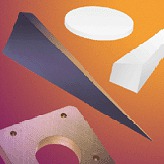cmcsales@ppg.com

Dielectric Materials

Dielectric Materials
 Cuming Microwave manufactures a full line of low loss dielectric materials. A dielectric material is a material that doesn’t conduct electricity well, but polarizes well. This lets it interact with electrical fields without the fields collapsing into electrical current.
Cuming Microwave manufactures a full line of low loss dielectric materials. A dielectric material is a material that doesn’t conduct electricity well, but polarizes well. This lets it interact with electrical fields without the fields collapsing into electrical current.
When these materials are placed in an electrical field, the atoms in the material become polarized. They are used in applications like capacitors and radio frequency transmission lines. In the latter case, the dielectric material channels the signal down the wire without letting it leak out, preventing interference. Inside a capacitor, a dielectric material is placed between two conductors. The properties of the dielectric material allow a strong electrical field to build up on the conductors without discharging. However, if a strong enough charge to the system comes along, it overcomes the dielectric material and passes a much greater amount of electricity than normal. A simple example of a dielectric material is dry air. We’ve all felt static electricity in the air, but air itself doesn’t allow for easy conduction of electricity. However, if the field is strong enough the electricity will arc and create lightning.
Dielectric materials are measured on two main variables, dielectric loss and their dielectric constant. All of the materials on this page have low dielectric loss. This means that they don’t lose a lot of energy due to heat as the field moves through them. This is important in applications where components are built compactly. The dielectric constant is a measure of how well the material concentrates electrical fields. The larger the constant, the more charge it can store. Thus, a capacitor made of a high dielectric constant material can store more energy in a smaller space. Our materials range in dielectric constant from 1.05 to 25.
Dielectric materials can be used to adjust the Q of cavities, as impedance transitions, substrates for stripline antennas, in transmission lines, smart skins, as dielectric radomes, dielectric spacers, or for circuit substrates. Whatever type of material specifications you need, Cuming Microwave will work with you to supply it. Our products are available in rod or sheet form, packinplace syntactic foam, rigid foam sheet stock, or as a two component foaming system. We can help assist you in choosing which type of material is best for your specific application. In addition to standard configurations, we can custom fabricate components and work with our customers to find creative solutions to tough problems.
Click the links below to learn more about each standard product.
- Plastic Stock With Adjusted Dielectric Constant – C-STOCK AK and AK-500 (210-1)
- Low Dielectric Constant, Low Loss Sheet Stock – C-STOCK LowK (210-2)
- Very Low Loss Polystyrene Sheet and Rod Stock – C-STOCK .0005 (210-3)
- Low Dielectric Constant, Low Loss Structural Foam – C-STOCK RH (210-5)
- Flexible, Low Loss Foam – C-FOAM PF-2 and PF-4 (210-6)
- Flexible, Weatherproof Low-Signature Plastic Fabric – C-STOCK HCN (210-7)
- Rigid Foam-In-Place Liquid Polyurethane – C-FOAM PK (210-8)
